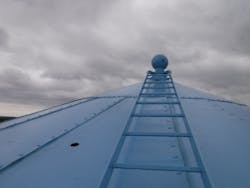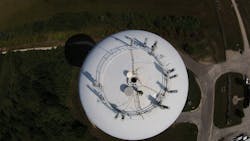The importance of a proper tank inspection cannot be understated. A lack in doing so may land a utility in hot water, such as an investigation by USA TODAY and Indiana University’s Arnolt Center for Investigative Journalism published in May 2021 exposing gaps in water tank oversight, leading to public health risks.
In March 2020, residents of Delray Beach, Florida, had noted concerns about the quality of water coming through their taps. Sediment had accumulated inside one of the city’s water storage tanks, which had not been cleaned since its 1972 construction.
In general, water tanks are part of an overall drinking water infrastructure for which the American Society of Civil Engineers has given a C- in its 2021 report card, noting that the system is aging and underfunded.
Tank Inspection & Maintenance Schedules
Each state determines its own tank inspection and maintenance schedule. The Association of State Drinking Water Administrators notes it is widely recognized that storage tanks should be regularly inspected to ensure integrity.
In a September 2020 survey of its members, most respondents indicate their states inspect water system storage tanks during their regular sanitary surveys of water systems, with 38 states (95% of respondents) inspecting ground storage tanks; 35 states (87.5% of respondents) inspecting reservoirs; 37 states (90% of respondents) inspecting standpipes or elevated storage tanks and five states (12% of respondents) inspecting other tanks such as pressurized tanks and booster station tanks.
The survey also showed that for some states, storage tank inspection also includes pressurized tanks, booster station tanks, and smaller ground storage tanks such as atmospheric tanks.
Most states complete inspections through the sanitary survey process, others hire contractors to inspect storage tanks, and at least one state requires the system to self-inspect storage facilities.
While tank inspections typically occur every three to five years, some states require an annual inspection and others have no specific interval requirement.
Most states examine facilities through outside visual inspections – most often with a person – while some use cameras and drones. At least nine states conduct an inside visual inspection when safe, although some note that climbing ladders to do so can present safety challenges. Visual inspections help identify sediment buildup or if animal carcasses have contaminated the supply.
Several states indicated they determine storage tank reliability by combining visual inspections with examining tank maintenance records.
Annual Tank Inspection Considerations
Several factors need to be considered when inspecting for the security, health, and safety of a tank, said Todd Schaefer, a Dixon Engineering project manager who has presented on the issue of tank inspection.
For annual security inspections, the tank access should be reviewed, he says. In so doing, check to see if the site on which the tank is located is fenced in and locked to unauthorized entry.
He offered other considerations: Does the ladder have a vandal guard? Is it locked in a base bell? Or is it unrestricted access? Check the overflow pipe discharge.
“Is it screened? Is there a flap gate? Or is it not covered? Is the screen intact, clogged or have holes in it?” Schaefer said.
In inspecting the roof vent, check to see if the screen is intact.
“Are there any openings on the roof to the wet interior? Are there open cathodic caps, missing air gap seals, missing couplings?” Schafer asked.
If the tank has a cathodic protection system, Schafer advises to look into whether there are any records that indicate it has been checked recently.
5-Year Inspection Considerations
In conducting a five-year inspection, several elements need consideration, Schaefer pointed out.
The inspection should include an examination of all items that are common concerns for an annual security inspection, including fencing, access, pipe discharge overflow, roof venting and cathodic protection systems.
A structural evaluation also should be conducted. In conducting a coating evaluation, Schafer advised that both interior and exterior coatings be examined. Cathodic protection system applicability also should be part of the inspection.
Review public health considerations on both the federal U.S. EPA and state agency levels with respect to upgrades to the tank, Schafer added. OSHA and other considerations for the tank also need to be considered. The inspection also should encompass site restrictions, electric lines near the tank or other structures that can interfere with containment, Schafer said.
Also check to see if there is sufficient space to stage equipment for tank rehabilitation.
When conducting a tank inspection, “there are more than 100 different items that may be used on an inspection,” Schafer said.
Tools for Tank Inspection
“Some inspection tools include a pit gauge, steel thickness gauge, tape measures, safety equipment such as harnesses and lanyards for fall protection, air monitor, rescue systems, ladders, ropes, power washer with accessories, hoses, pales, shovels and other miscellaneous tools,” he said.
There are times when an operation should have a dry inspection conducted, too.
“If they have more than one tank in the system, a dry inspection would be preferred so structural and coating repairs can be more accurately quantified for bid specifications,” he said. “Also, if cleaning the wet interior is desired, a drained inspection provides more thorough cleaning.”
In-service inspections make sense “when there is only one tank in the system, it maintains fire protection reserve,” Schafer said. “Also, an in-service inspection places the tank back in service sooner. It also helps with water conservation.”
The U.S. EPA Region 8 Drinking Water Unit has a detailed finished water storage tank inspection/cleaning checklist at bit.ly/epatankchecklist. The document notes the need for inspector qualifications such as confined space training and confined space entry. The checklist delineates inspection points such as overall tank condition, including structural integrity and the presence of unprotected openings.
Significant deficiencies on the air vent to note include a vent separate from the overflow. For ground level or elevated above-ground tanks, inspections should note the spacing of a downturned vent from the roof. For non-downturned vents, the inspection should note whether it encompasses a solid cover down to the bottom of the vent screen and whether the screen is at least 8 inches above the roof surface.
Also to be noted is the height of the start of the screening above the tank and whether the vent is covered with a #24 mesh corrosion resistant screening, with some exceptions applicable.
Factors to consider for buried or partially buried tanks include an examination of the air vent as well as the access hatch.
Conditions that factor into overflow inspections of tanks include the presence of an overflow separate from the vent, the condition of the mesh corrosion resistant screen, a duckbill valve or a sealed flapper valve with a screen inside.
Overflow discharge paths and termination points also are considered in the inspection. Blockages as a result of inadequate sizing, a malfunction of the level control system or other issues are considered, including the visibility of the overflow discharge point.
Deficiencies of note for the drain components include air gaps, termination points and discharge components such as a mesh corrosion resistant screen, duckbill value or sealed flapper.
In terms of cleaning, inspection considerations include the depth of sediment prior to cleaning, the manner in which cleaning occurred, post-disinfection practices and the presence of any animal carcasses or debris, with an immediate notification to the EPA.



